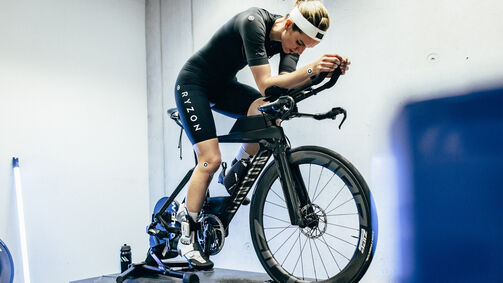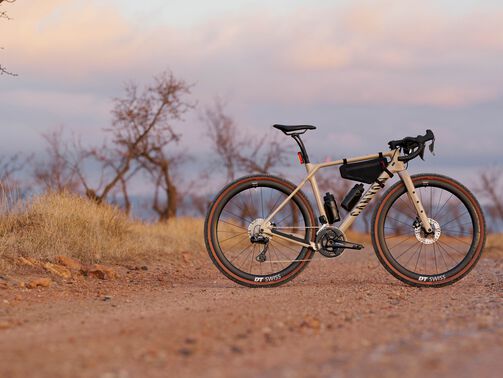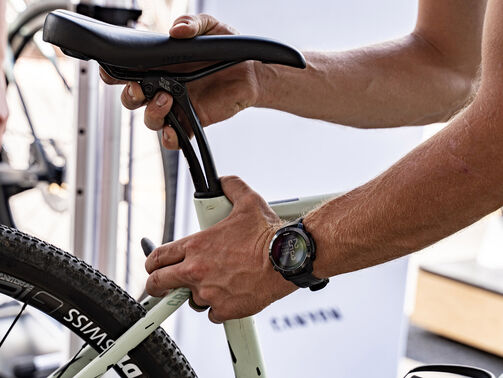Road bike geometry explained: Your ultimate guide to frame design
A road bike’s geometry defines its design and how it rides. But how? Let’s take a look.


A bike’s geometry ultimately determines both its size and how it handles on the road. Bike geometry can be a bit complicated, but we’ll try to make it as easy to understand as possible, while comparing the different types of bikes Canyon offers, from race bicycles to endurance machines to cyclocross bikes.
Contents
What is road bike geometry and why is it important?
On one end of the spectrum, you have racing bikes. Often described as aggressive, they're twitchy and highly responsive. Your body position on a racing bike will be lower and longer, which can challenge your flexibility and comfort over longer distances.
The tubes used to build racing bikes are often aerodynamic and they're designed to be stiff, so that power transfer is high. Put simply, these road bikes are designed to be fast, efficient, and first over the line.
At the other end of the spectrum are endurance road bikes. With their slightly more upright, relaxed riding position, they’re smooth and comfortable on longer rides. Though you'll still be able to chase your friends on the road, an endurance bike is less aerodynamic and the bike won't be quite as responsive as a racing bike.
How does frame size affect geometry?
The size of the frame determines how they handle; bigger frames handle differently to smaller frames. Frame size also subtly affects geometry as well. Due to longer tubes, a larger bike frame may be slightly less rigid than a smaller frame. While this means a less-efficient power transfer, that small flex increases comfort over longer distances.
A smaller bike frame does not leave much room for wheels. For this reason, we spec our smaller framed bikes with smaller wheels to avoid toe overlap (your foot rubbing on the front wheel and tyre when turning), create more balanced weight distribution and agile handling, and to maintain steering behaviour to larger bikes with 700C wheels. You'll find 650b wheels on our road bikes and gravel bikes.
Finding the right size using effective stack and reach
Perhaps the two most important numbers on any bike's geometry chart are stack and reach. Sizing between bike models and manufacturers can differ despite two bikes being the same size. A Canyon Aeroad in a size medium will feel different to a medium Canyon Endurace because their stack and reach are different.
Stack refers to the vertical height from the bottom bracket to the top of the head tube, while reach is defined by the horizontal distance between the center of the bottom bracket and the head tube. A longer reach means you’re more stretched out on the bike, with your hands moving further forward. A bigger stack means a more upright riding position.

Stack and reach generally gives you a good indication of your riding position, but it can get a bit more complicated. Reach is useful if you are comparing similar road bikes. Many modern bikes have longer reach measurements, but shorter stems, giving more control over the front of the bike. A longer wheelbase means a longer reach, making the bike feel more stable at high speeds.
Before ordering your new Canyon, be sure to jot down the stack and reach numbers of your current bike. If you know what ride characteristics you want in your new bike, look for stack and reach measurements as close to those desired numbers as possible, using your old numbers as a baseline.
Is stack or reach more important? It depends on the type of riding you do. Reach tends to matter more for aggressive, race-oriented riding, as it affects how stretched and aerodynamic your position is. For endurance, gravel, or relaxed riding, stack is often more important, offering a higher front end for greater comfort on long rides.

Effective stack and reach
Canyon has gone a step further with our geometry charts; calculated based on your hand positions when gripping the hoods, these effective stack and reach numbers translate more accurately into real world feel.
Effective stack is the vertical height between the bottom bracket and point where you grip the hood, while effective reach is the horizontal distance from the bottom bracket to the point where you grip the hoods.
These measurements take into account the stem length and shape of the cockpit, plus the spacers fitted as delivered. The riding position on a Canyon Grail is more upright (greater stack) than on a Canyon Aeroad due to the headset spacers.
Common geometry measurements and why they're important
Although stack and reach may be the two most important measurements to take into account when buying or fitting a bike, there are several other geometry measurements to consider as well.
Standover height
Standover height is important when purchasing your ideal size bike because you need to be able to put two feet on the ground when stopped. (It’s not going to feel comfortable if you’re on tip-toes at every stoplight!) To get the road bike’s standover height, measure from the midpoint of the top tube to the ground.

Top tube length
A road bike’s top-tube length and reach are closely related: A top tube too long for your body type means you'll be stretched out too far, while a too-short top tube will have you cramped up on the bike with your knees hitting your elbows.
Racing bikes like the Canyon Aeroad and Ultimate typically have a longer reach than endurance bikes like the Canyon Endurace. The longer reach means a lower, more stretched out, and aggressive racing position for the rider. However, using the top tube length as an indicator of seating position is somewhat outdated and has been replaced by effective stack and reach. This is because most modern bikes rarely have a horizontal top tube.
The adjustable CP0018 cockpit offered on many Canyon racing bikes allow you to tweak your reach and dial in your riding position perfectly.

Seat tube length
The distance between the center of the bottom bracket and the top of the seat tube, seat-tube length indicates how much of your seat post will be exposed when setting the bike up.
Oddly enough, the amount of seatpost exposed actually affects your bike’s ride. Very little seatpost exposed means the road bike generally feels stiffer to ride. If you have a lot of seatpost exposure, you’ll notice more flex and a more comfortable ride.

Head tube length
Head tube length feeds into the stack measurement. A shorter head tube (like those seen on racing bikes) means a lower position on the road bike, with your handlebars sitting lower down (assuming you don't use any spacers). A longer head tube means a more upright seating position.

Head tube angle
The head tube angle – the angle at which the front wheel sits relative to your head tube – helps determine a road bike's stability. If the front wheel of a bike sits further forward, then the wheelbase will be longer, and the bike will usually be much more stable at high speeds.
This measurement is one of the more important aspects of mountain bike geometry.

Seat tube angle
The seat tube angle is measured from the horizontal to the tube. This angle dictates the degree to which you ride over the pedals and bottom bracket. A steeper seat tube angle means you ride more over the pedals, which is generally preferred by road racers, time-trialists and triathletes.
It encourages a lower position on the road bike and prevents stress on the thigh muscles over long periods. A slacker seat tube angle is a bit less efficient, but more comfortable.
Canyon road bikes use a balanced seat angle of 73.5°, which puts you in a balanced position in the center of the bike – great both on the flats and on climbs. In contrast, the Canyon Speedmax triathlon bike has an extremely steep 80.5° seat angle to put you in a very aggressive aero position over or almost in front of the bottom bracket.

Chainstay length
Chainstay length is closely linked to the overall wheelbase of a road bike. Race bikes typically feature shorter chainstays to keep the handling agile and reactive. The Endurace, which prizes comfort and stability on the road, has a slightly longer chainstay, 415 mm (size L) than the Ultimate’s 413 mm; 2 mm difference may seem like a minute amount, but you can feel the difference on the bike.

Wheelbase
The wheelbase is the distance between the hubs of both wheels. The longer the wheelbase, the more stable the ride. For example, with a wheelbase of 1003 mm (size L), the Canyon Ultimate produces a snappier, more responsive ride than the Canyon Grizl gravel bike, which has a much longer wheelbase of 1050 mm (size L).

Bottom bracket offset
The bottom bracket offset is the distance between the horizontal line of the bottom bracket and the horizontal line between the wheel hubs. Sometimes referred to as the “bottom bracket drop,” this particular measurement helps determine a bike's stability. A bigger offset means the bike has a lower center of gravity.
For example, cyclocross bikes, like the Canyon Inflite, have a lower offset number than an Canyon Aeroad because of the obstacles it must face on the course.

Tyre clearance
Tyre clearance should be an important consideration for anyone buying a road bike, telling you not only which tires are compatible with your bike's frame and fork, but also giving you an insight into its capabilities.
Years ago, most experts thought the skinnier the road bike tire, the better. Many pros rode on 19 mm skinnies for their entire career. But between research pointing toward wider tires being better and technological advancements like disc brakes, most road bikes come with 25 mm or even 28 mm tires standard.
A bike with wider tire clearance will be suitable for more off-road pursuits compared to one with narrower clearance. Wider tires increase comfort, but also increase the rolling resistance, so you'll need to find your ideal balance.

Canyon road bike geometry categories and comparisons
If this seems overwhelming to you, you’re not alone. Let’s break down some of the numbers and definitions by road bike types.
Race bike geometry – Aggressive and aerodynamic
When looking at the Ultimate and Aeroad SLX 8 Ultegra Di2 models in a size medium, the numbers are strikingly similar. Both the Aeroad and Ultimate have the same stack height (560mm), reach (393mm), chainstays (410) and wheelbase (988). The Aeroad has a slightly taller standover height (810mm) and longer top tube length (559mm) versus the Ultimate (803mm and 555mm, respectively).
What does this mean in real-world terms? Previous versions of the Aeroad had a much more aggressive geometry to take full advantage of its deep, aerodynamic tubes. But after getting feedback from the pro peloton, including Tour de France green jersey winner Jasper Phillipsen, Canyon relaxed the rider positioning, opting for the Pro Sport geometry of the Ultimate. The Aeroad’s longer top tube means riders will be stretched out ever so slightly more, putting them in a bit more of an aerodynamic pedaling position.
Endurance road bike geometry – Comfort for long distances
Compared to the race bikes, the Endurace’s geometry is more relaxed, but still fast. The Endurace (size M) offers a stack height of 590 mm, 30mm higher than the Ultimate and Aeroad, while the reach (378 mm) is shorter, making for a more relaxed ride. The longer chainstays (415mm) and wheelbase (993mm) of the Endurace add to its stability.
This is a great road bike for beginners and experienced riders alike.
Aero road bike geometry – Speed and efficiency
Both the Aeroad and Speedmax were designed to slice through the wind and are among the fastest bikes in their categories. But the numbers show just how different the bikes are.
The size medium Aeroad’s stack height (560 mm), reach (393 mm), chainstays (410 mm) and wheelbase (988 mm) create a bike that’s fast and nimble, while still maintaining comfort over long distances. By comparison, the Speedmax’s stack (489 mm), reach (438 mm), chainstay (420 mm), and wheelbase (1,014 mm) stretches the rider out and provides stability at speed. This is not the bike you’re taking on a weekend ride with friends; this is the bike you ride when you want to dominate your local triathlon or time trial race.
Cyclocross geometry – Versatility and stability
A cyclocross bike is a truly unique beast – designed to be an aggressive race bike, but with the stability of an off-road bike. The Inflite’s stack height (572 mm) falls between the Endurace and Ultimate, while the reach (393 mm) matches the Aeroad. The chainstays (425 mm) and wheelbase (1,018 mm) are actually longer than the Speedmax.
While this bike is designed to conquer cyclocross courses, you could also take it on a gravel ride or on a fast-paced road ride with slick tires.
How to choose the right road bike geometry for you
So what road bike geometry will be the best option for you? It all depends on your typical riding style and goals. If speed and dominating your local crit series is your priority, the aggressive geometry of the Aeroad or Ultimate should serve you well. If you prefer long-distance rides in relative comfort, the relaxed Endurace is your bike. The super-aggressive and stretched-out geometry of the Speedmax will help make your tri dreams come true. If you’re looking for a versatile ride that’s stable off-road, then you should move the Inflite to your virtual shopping cart.
For a deeper dive into Canyon’s road bike lineup, head over to our road bike buying guide.
To delve into the geometries of each Canyon model, check out our bike comparison tool. Just hit the link to the tool at the bottom of the page, and you can choose three models to analyse geometry, components, and more. If you still can’t decide, try taking them for a test ride at one of Canyon’s demo centers such as the one in Carlsbad, California and test ride centers in Europe.
Luckily, if you feel like you’d be happier on a different model after a few rides, you can easily exchange your purchase, thanks to Canyon’s generous 30-day return policy.
Discover our Road Bikes
Did this article help?
Thank you for your feedback
-
 About the author
About the authorRobert Annis
Robert Annis is an award-winning outdoor-travel journalist. As an experienced writer and sport enthusiast he writes content that is inspiring with focus on road biking. You might have read Robert's articles in Bicycling, National Geographic, Outside, Travel + Leisure, Inside Hook, AARP, Midwest Living, Sierra, Hemispheres, Departures, Lonely Planet, Afar, Los Angeles Times, Chicago Tribune, RV Magazine, and Hidden Compass.











